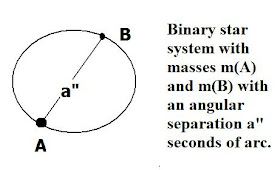Answer:
Below I sketch a basic binary star system for reference:

The diagram above shows the simplest type of system, with the plane of the binary components A (of mass m(A)) and B (of mass m(B)) perpendicular to the viewing plane. This visual binary system, it's important to note, indicates the apparent relative orbit of the 2 stars - since ordinarily (as you pointed out) - the plane of the real orbit will not lie in the plane of the sky, i.e. perpendicular to the line of sight as portrayed. Usually, what we do is observe the motions of the fainter member about the brighter over a period of time sufficient to determine the orbit period, and then obtain the apparent relative orbit.
It is this circumstance which makes it possible to determine the inclination of the true orbit to the plane of the sky. Basically, the problem reduces to finding the angle at which the true relative orbit must be projected in order to account for the amount of displacement of the primary from the focus of the apparent relative orbit.
If the semi-major axis of the true relative orbit (e.g. the one it would have if displayed face-on) has an angular distance of a" (seconds of arc) and if the system is at a distance d parsecs, then the semi-major axis in astronomical units is:
a = (a" x d)
Then the sum of the masses of the two stars is given by Kepler's 3rd law:
m(A) + m(B) = (d a")3/ P2
where P is their period.
We first obtain the total mass from Kepler's 3rd law:
m(A) + m(B) = (d a")3/ P2 =
(2.67 pc x 7.5") 3/(50 yr)2 = 3.2 solar masses, i.e. 3.2 Ms
So:
m(A) + m(B) = 3.2 Ms
But in terms of the center of mass:
A O------------x cm-------------------------o B
where: xB = 2 (xA)
Then:
xB/xA = 2, and: m(A)/m(B) = xB/xA = 2/1
so: m(B) = ½ m(A)
(since the more massive star is always closer to the center of mass)
so: m(B) = ½ m(A)
(since the more massive star is always closer to the center of mass)
Thus,
m(A) » 2.13 Ms, and m(B) » 1.06 Ms
Spectroscopic
binaries are also of much interest and derive their name because spectroscopic
analysis is needed to obtain the radial velocity curve for the system and hence
the relative orbital velocity, V, for the pair. The distance around the
relative orbit, i.e. its circumference, is just the relative orbital velocity V
(deduced from the radial velocity profile) multiplied by the period P. Then the
distance between the stars a, is just:
a = (V x P)/ 2π
a = (V x P)/ 2π
If, for instance, the relative velocity
is a lower limit, then the separation we obtain is a lower limit for the
system. If this is then applied to Kepler's 3rd law one can obtain a lower
limit to the sum of the masses of the components:
m1 + m2 = a3/P2
m1 + m2 = a3/P2
To fix ideas, say a spectroscopic
binary system is found to have a relative velocity of 100 km/sec and a period
of 17.5 days. Then let component
(1) be 3 times the mass of component (2) and find: a) a
lower limit for the separation of the components, a, and thence a lower limit
to the sum of the masses, and b) the
lower limits on the masses of the components.
First convert 100
km/sec to AU/yr. (Astronomical units per year)
Over one year: t = 3.156 x 107 s
total distance covered:
Over one year: t = 3.156 x 107 s
total distance covered:
But 1 AU = 1.495 x 108 km
Then, the AU in this total distance:
d/AU = (3.156 x 109 km)/ (1.495 x 108 km) = 21.1 AU
The period in yrs. for 17.5 days:
P = 17.5/ (365.25) = 0.048 yr.
Then:
a = (21.1 AU x 0.048 yr/AU)/ 2π = 0.161 AU
The lower limit to the masses is therefore:
m1 + m2 = (0.161)3/ (0.048)2 = 1.8 solar masses
Since star m1 has
3x the mass of star m2, then: m1
= 3m2
And: m2 + 3m2 =
1.8 or 4m2 = 1.8
so:
m2 = 1.8/4 =
0.45 solar masses, and
m1 = 3(0.45) = 1.35 solar masses
Basically, in working any binary star problem, say to get the relative masses, one needs to take care the units used are consistent, and also that Kepler's 3rd law is applied in the correct format.
No comments:
Post a Comment